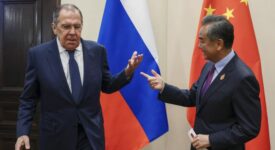The idea of a “geopolitical Commission” was officially announced in 2019. But it has been Russian President Vladimir Putin’s full-scale invasion of Ukraine on 24 February 2022, that has given a belated birth to a “geopolitical Europe,” as stated by the EU’s foreign affairs chief Josep Borrell. So this time around, is it for real and for good?
Russia’s war in Ukraine may have woken the EU up to the necessity of being a fully-fledged hard power. The EU’s economic statecraft arsenal does count as a kind of hard power: banks can coerce as much as tanks. But in today’s world, hard power’s other — military — arm is the EU’s critical necessity. Capacities alone, however, are not enough to render the union a real power — for many meaning “realist”, that is, a security actor. The EU’s long-standing unrealism has been premised not so much on lacking capabilities but on the conflation of missing will, strategy, and capacity to act. The union is so often regarded as doing too little and too late in response to serious security challenges abroad.
Take a case of the latter: the EU’s advisory and military training mission (EUATM), which Ukraine has been requesting since 2015, was only agreed “in principle” a few days before Russia’s 24 February invasion. Weeks into the war, Borrell was still urging EU member states to speed up their military assistance to Ukraine. As regards the “too little” aspect of the EU’s unrealism, the bloc’s deterrence of Russia failed long before the 2022 war, first in 2008 when Russia invaded Georgia and then again in 2014 when Russia annexed Crimea and invaded parts of eastern Ukraine. The politics of “deep concerns” and half-hearted sanctions defined the EU’s stance on the violation of borders in the twenty-first century. Assuming that Putin’s miscalculation of the current military campaign was based on the expectation of yet another “too little” type of EU response would not be far-fetched.
But in a surprise move, on the third day of the invasion, the EU agreed to provide under the July 2021 European Peace Facility (EPF) — and thus off-budget — some €500 million to supply the Ukrainian armed forces with weapons. Untypically, the sanctions response was also prepared preemptively, for the first time, in anticipation of the Russian breach of law. Moreover, shortly before the war broke out, the EU sent its Cyber Rapid Response Team to Ukraine, pioneering another Permanent Structured Cooperation (PESCO) instrument of differentiated integration and cooperation being deployed to a third country. The EU’s initial response based on these three decisions was swift and hard. Big taboos fell as the EU bid farewell to its unrealism. As The Economist stated, “with war at its doors, the EU discovers a capacity for action.”
Embracing real(ist) power, however, requires a further consolidated effort in forging political will, sharpening strategy, and bolstering capabilities. The record shows some progress but also limitations. There is a noticeable crescendo in the EU’s discourse and understanding that “reckless adversaries” won’t be deterred either by soft or normative power capabilities. Yet Europe needs to think ahead in terms of its hard-power projection and coercion instruments as well as its defensive anti-coercion instruments. As Russia’s pressure with rubles-for-gas payments or gas delivery cuts (so far, to Poland and Bulgaria) starts to mount, such anti-coercion instruments are urgently needed — and could well be included in the sixth package of EU sanctions.
As for the EU’s strategic outlook — essentially molding a new reality — the March 2022 Versailles Declaration called for a common responsibility to “protect EU citizens, values and democracies and the European model” while “bolster[ing] EU defense capabilities, reduc[ing] energy dependencies and build[ing] a more robust economic base.” And on 21 March, the EU adopted its first-ever defense strategy based on the Strategic Compass. It is structured around four pillars: act, invest, partner, and secure. In theory, an EU Rapid Deployment Capacity, along with capability-building initiatives, should join up member states’ national and institutional resources and targets. This still requires operationalization and prioritization, a task that the forthcoming informal defense summit of the European Council has to deal with. Strategic resolve includes not only a readiness to deal with severe security crises below NATO’s Article 5 threshold, but also to substitute, at some point, the United States as a security provider in Europe. Europe’s strategic autonomy could come into play.
Signs of fading unity in the context of the European response to Russia’s invasion should not be underestimated. There are big gaps among the EU member states when it comes to the provision of aid for Ukraine. It is true that as of mid-April 2022, the EU tripled the initially allocated budget, mobilizing €1.5 billion under the EPF for Ukraine. From the EPF’s €5 billion fund earmarked for strengthening the EU’s military presence, one-fifth has been already secured for supporting Ukraine’s defense effort. While it may seem like an impressive aid package, it’s a rough equivalent of the EU’s daily energy payments to Russia.
And then there’s the enlargement issue. On 28 February 2022, President Volodymyr Zelensky signed Ukraine’s application for EU membership. The European Commission can fast-track the procedural side of things, but firm and consistent signs of a political breakthrough on Ukraine’s membership bid from many member states have been missing. Hesitation is a costly luxury in times of war. Little if anything would justify the EU’s hesitation to grant candidate status now — perhaps at the June 2022 summit. After all, the path from EU candidate status to full membership is anything but short, straightforward, and certain. Such a decision by the EU would also feed into making “geopolitical Europe” a real force — not just a brand — in international power politics. Adaptation, not ambiguity, could offer a way forward for post-war EU-Ukraine relations.
Indeed, the opening of the EU’s differentiated integration and cooperation projects in defense and security area to third countries, PESCO plus, shows early signs of the EU’s adaptability to a rapidly changing security environment. More recently, on 13 April 2022, the EU Council amended the mandate of the EU Advisory Mission for Civilian Security Sector Reform in Ukraine (EUAM Ukraine) to provide support for the investigation and prosecution of Russia’s war crimes in Ukraine. The EU has taught Ukraine how to build democracy. Ukraine is teaching Europe how to defend one. As the Russian surreal spirit of “mozhem povtorit” (“we can do this again”) lives on, the EU’s “never again” will always fail unless the bloc gets real(ist) about its own security.
‘Made in Ukraine: The EU’s Emerging Real(ist) Power’ — Blog Post by Andriy Tyushka — Carnegie Europe.







